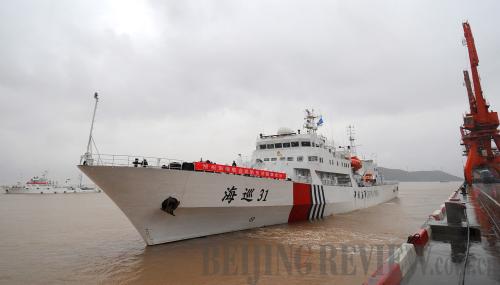|
 |
|
MARITIME SECURITY: A Chinese patrol vessel leaves a port in Zhoushan, in east China's Zhejiang Province, for a mission in the East China Sea on April 14, 2010 (XU YU) |
On December 17, 2010, the city assembly of Ishigaki, in Japan's Okinawa Prefecture, designated January 14 as the "pioneering" day of the "Senkaku Islands," known as the Diaoyu Islands in China.
China's People's Daily recently published an article condemning the announcement based on historical documents. Edited excerpts follow:
The date of January 14 was chosen because it was on that day in 1895 that the Japanese Government secretly adopted a decision to erect markers on the Diaoyu Islands. Since then, the islands have been illegally under the jurisdiction of Ishigaki City.
As everyone knows, China has indisputable sovereignty over the Diaoyu Islands, which have been Chinese territory since ancient times. They have never been terra nullius—land that has never been subject to the sovereignty of any state. It is absurd to steal land from other countries and regard it as a pioneering action.
When Japan invaded northeast China during World War II, Japanese organizations for migration to China were referred to as "pioneering teams." Here "pioneering" is merely a synonym for colonial expansion.
In light of Japan's behavior in regard to the Diaoyu Islands, though, perhaps January 14 should be considered a "stealing" day rather than a "pioneering" day.
Secret investigations
The truth about this disgraceful part of Japanese history is detailed in official Japanese documents. According to Volume 18 of Nihon Gaiko Bunsho (Documents on Japanese Foreign Relations), Japan's Meiji government conducted three secret investigations in the autumn of 1885. These investigations led to the conclusion that the Diaoyu Islands were not terra nullius, but actually belonged to China.
The documents say the first investigation concluded on September 22, 1885, when Okinawa's Governor Stezou Nishimura reported to Japan's Home Ministry. He said that upon viewing the three islands—which are now called Taisho Jima, Kuba Jima and Uotsuri Jima in Japan and in fact are Chiwei Yu, Huangwei Yu and Diaoyu Dao in China—he could not confidently say the islands were under Japanese rule. Based on the islands' terrain, he felt they may be Chiwei Yu, Huangwei Yu and Diaoyu Dao, which were first detailed in the Annals of Zhongshan, a book on the history and culture of the Ryukyu Kingdom written in 1710 by Xu Baoguang of the Qing Dynasty (1644-1911).
This proves that, at the time, the local government of Okinawa knew the islands may be Chinese territory, and was worried an occupation would infuriate China.
But Japan's Home Minister Aritomo Yamagata refused to give up. He requested a second investigation to pave the way for the construction of markers on those islands, under the false assumption that there was no sign the islands belonged to the Qing government of China. However, the second investigation prevented Japan from taking further actions, as it alerted the Chinese media. Shen Bao, a Shanghai-based newspaper, published a story saying, "Recently, Japanese people have hung their national flag on the Chinese islands to the northeast of Taiwan, showing an intention of occupying these islands."
While the Japanese Meiji government accelerated secret investigations of the islands, it also kept a close eye on China's reaction through Chinese newspapers.
At the conclusion of the second investigation, Japanese Minister of Foreign Affairs Kaoru Inoue wrote a letter to Yamagata on October 21, 1885. In it, he said the islands were close to the Chinese territory and acknowledged that they bore names given by then Chinese government. Inoue knew Chinese papers were reporting on the Japanese interest in the islands and was wary of suspicion from the Qing government. He decided that if Japan were to currently occupy the islands, there would be repercussions and it was deemed better to wait.
This investigation further confirmed the fact that the Diaoyu Islands belonged to China. Inoue specifically warned Yamagata not to allow the secret Japanese investigations to appear in newspapers, and he warned that subsequent investigations should be carried out in secret to avoid China's opposition.
Then, on November 24, 1885, Governor Nishimura reported to Yamagata seeking direction at the end of the third investigation. He wrote that China likely wouldn't stand by idly if Japan erected markers on the islands. He asked for a quick response detailing how to deal with disputes over the islands, should they arise.
| 